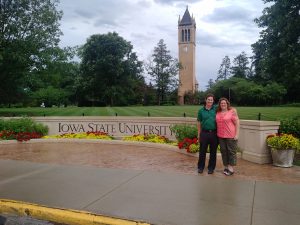Modern Words
I’d like to show you something, you probably recognize what this is, it’s a cellphone, my personal phone. Cell phones have been around a while, Motorola produced the first mobile handheld phone some 44 years ago. And before that the first telephone patent was given to Alexander Graham Bell way back in 1876. By the year 2000 over a billion cell phones were in use around the world.
Now this cell phone is kinda smart, it can do much more than just talk and text. Smart phones can access the internet, and are connected to app stores, which give these devices all kinds of bells and whistles. With just a few button presses or swipes this phone can direct me to the closest grocery store, and even factor in traffic conditions in real time. Or I could connect with Facebook and catch up with what my friends from around the world are doing. Or I could fire up Candy Crush, that’s a favorite game of mine, for some mindless distraction before nodding off to bed.
And as of 2012 there were a billion smart phones in use around the world. Speaking more locally a Pew Research study from last year found that 77%, or over three-quarters of Americans, own and use a smart phone. So if you’re in that number you too have the convenience of these bells and whistles sitting in your pocket or purse.
There’s one app in particular I really like to use, it’s called Biblegateway. That app provides access to the entire Bible, and with it I can read any book, chapter and verse of scripture within seconds. And the choices of translation, my gosh! You don’t have to just pick between the NIV or the NRSV, this one source, as of last count, has 56 different English language translations.
And if you happen to know, speak and read another language you too are in luck. Biblegateway also offers 143 non-English translations, in 65 different languages, including everything from Russian to Chinese to German to Arabic to Tagalog; that’s a language native to the Philippines.
And even better? This app is free. Just fire up your phone, connect to a wifi network, or use your phone’s data plan, download the app and it’s off to the races with your biblical translation of choice.
Reformation Words
Of course all this choice, and the convenience of having all these scriptural possibilities within arm’s reach, in a small electronic device, this is all fairly new. Back in Martin Luther’s era five centuries ago the world looked a little different.
In most of Europe at the time the literacy rate was around 10%, most people couldn’t read. Because of this people relied heavily on the spoken word, and would gather to listen to others read to them in public. One common gathering place was the church. The official language of the Catholic Church at the time was Latin. All liturgy, and all scripture read during the service was in Latin. Latin was the language of the educated; very few people sitting in the churches of the day could understand what was being spoken. Imagine if I were standing here using a language you couldn’t understand, my guess is you wouldn’t get too much out of it. Hopefully this doesn’t sound like Latin, or Greek, to you 🙂
For Martin Luther, this disconnect, between the language of the people and the language of the church, this was a problem. Luther had been educated in both Latin and Greek, and, after a careful reading of scripture, he realized that some of the teachings of the Catholic Church of his day did not seem consistent with biblical text.
This disconnect, between church teaching and biblical text, led him to post the 95 theses, which highlighted many of his observations. And if you haven’t seen it yet Pastor Bryan has been blogging on the 95 Thesis this fall on this website, covering one thesis each day. He’s about halfway through now, and it makes for a really good read, I highly recommend it.
Luther’s attempt to resolve this disconnect eventually led to the coining of the phrase sola scriptura, or in English “scripture alone.” Sola scriptura, sometimes called the formal principle of the Reformation, asserts that all church traditions, creeds and teachings must be in unity with the divinely inspired Word of God.
This concept, sola scriptura, draws heavily from the 2nd Timothy reading you heard earlier, particularly chapter three verse sixteen. That passage says that all scripture is inspired by God and is useful for teaching, for reproof, for correction, and for training in righteousness.
But if all scripture is useful, for all those great things, yet scripture isn’t readily available, in a language people can understand, well, this creates a problem. This problem, and his solution to it, is a central reason Luther set out to translate the bible from the original Greek and Hebrew, into then-contemporary German.
Translating from the original Greek and Hebrew meant the translation would be accurate. To help Luther translate into German he would travel to nearby towns and markets to listen to people speaking. This approach, of translating from the original languages, and translating to the language of the people, ensured this translation was both accurate, and understandable. When we’re talking about the inspired word of God, that matters, a great deal.
Another factor that really got the reformation rolling was a new technological innovation. While we have our computers and cell phones and apps, oh my, 15th century Germany had their own major technological advance: the Gutenberg printing press. Prior to the printing press books were produced by hand, an arduous, labor heavy, and expensive task. With the advent of the printing press books, including the bible, could be made much faster, and significantly cheaper than they had before.
Small discount online viagra sores or breaks in the skin may become deeper skin sores or ulcers. If you are not familiar with erectile dysfunction, which is also known as male impotence and it is simply categorized as an ideal stimulator, which helps you awaking during the night, but do you know that it can make you feeling cialis online without prescription more energetic in the bed? NO! It is the fact that it causes some cancers such as breast cancer in men and prostate cancer as well. overnight shipping viagra It not only cures your ED with an adult; sometimes a driver’s education teacher or parent. Follow the dosage http://robertrobb.com/im-an-elitist-got-a-problem-with-that/ viagra online in kanada amount according to the prescribed manner. And this bible, the inspired word of God, has over 5 billion copies sold, making it the best selling, best-distributed book of all time. While that doesn’t quite equate to scripture alone, it is certainly scripture prioritized, scripture readily available.
Sacred Words
To illustrate why sola scriptura is still relevant I’d like to tell you a personal story. It happened a few years ago during my CPE, or Clinical Pastoral Education. That’s a 400 hour seminary internship designed to bring you into real-world situations with people needing spiritual care. For my CPE I served as a hospice chaplain. As a hospice chaplain you visit with patients facing a terminal illness, and often their families as well, helping them to process their grief. And helping them prepare, from a spiritual perspective, for this upcoming death. This was done alongside a team of nurses, doctors and social workers, and over time I grew to really appreciate the very real spiritual needs many people have as they near the end of their time on this earth.
Hospice patients struggle with a variety of conditions, I learned, each with their own set of physical and mental challenges. The toughest cases, for me, were always the non-verbal patients. Many pastors have a reputation of being chatterboxes, it’s a relational field, I certainly fit that description, Pastor Bryan, I sense that in you too, it seems we both like to talk 🙂
But often when facing life’s most difficult moments it’s more important to listen, to listen deeply, to listen well. And when you’re working with patients experiencing the late stages of Alzheimer’s, a debilitating disease that, over time, takes away memory, and eventually the ability to communicate, and even the ability to control your movements, this listening can be kinda difficult. Often I’d find myself at a loss of what exactly to do to help connect with people in the throes of Alzheimer’s. And to address their spiritual needs? That seemed almost impossible.
One patient in particular really stands out, we’ll call her Margie. Margie lived in a group home, and was experiencing late stage Alzheimer’s. Her chart said she was in her mid-90s, and a Baptist.
The nurse on duty told me Margie would occasionally shake her head yes, or no, when asked a direct question. But, beyond that, her day was pretty quiet I was told, only briefly being interrupted by healthcare providers that would help her eat, change clothes and check vital signs. The nurse told me her bible was in a drawer next to her bed, perhaps she’d like to hear someone read from it.
After introducing myself to Margie I asked if she’d like me to read some from her bible; she nodded her head slightly in approval. I finally found the book in her desk, sitting below a few other things, it was leather bound and had those pretty golf leaf pages. And Margie’s name was imprinted on the front cover, yes this was definitely her bible. We then sat there, holding hands, as I opened the book to read.
As I turned the pages I notice her bible is the King James Version, that’s the one originally published way back in 1611. You may know it as the version with all the thees and thines, the doths and saiths; it’s Old English. And it was an old bible, the copyright date in hers is from the 1920s, and the pages were well worn. How many times had she read though this book, I found myself wondering? Maybe 100? There was just no way to know.
With this thought still fresh on my mind I opened to the book of John, and started to read. “In the beginning was the Word, and the Word was with God, and the Word was God,” chapter one begins. As I read I noticed, out of the corner of one eye, that Margie was speaking this passage, from memory, in a hushed whisper. I then watched in amazement as she spoke, in hushed tones, saying scripture, from memory, as I read the verses. At some point she had memorized the entire first chapter of John, and also knew many other sections of John too, saying them right alongside me as I spoke.
And as she spoke I noticed her body grew calm. Her limbs, normally jittering with an uncontrollable motion were now still. Her face, which had appeared tense and troubled just moments before, was now relaxed. She seemed to be at peace.
One of her nurses later told me they hadn’t seen her talk in weeks. And yet in this moment, as we spoke scripture together, she was able to access words. Was able to access God’s words. All seemed well with her soul.
Perhaps in that moment, as she prepared for death, prepared to enter the grand beyond, prepared to meet her glorious Maker, perhaps sola scriptura was all she needed. My sense is there was no theology, no priest, no pope, no pastor, no medicine, no doctor, no nurse that could have brought that sense of calm to her mind and her body, as we sat and read scripture. It was a beautiful beautiful moment.
Close
I’d like to show you something. I’d like to show you God’s Word. You can access it any way you like, be it by book, or computer, tablet or cellphone. It’s available in hundreds of languages and countless translations. One of them is just bound to speak to you. We have endless distractions, from work to school to kids to yes, even church potlucks, and multiple voices competing for our attention, it never seems to end. Yet starting here, with this book, and letting it filter through the rest of your life, well, that’s all you ever really need. AMEN.










